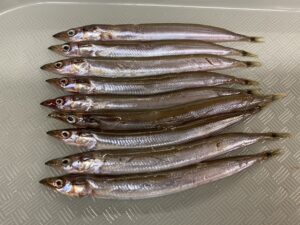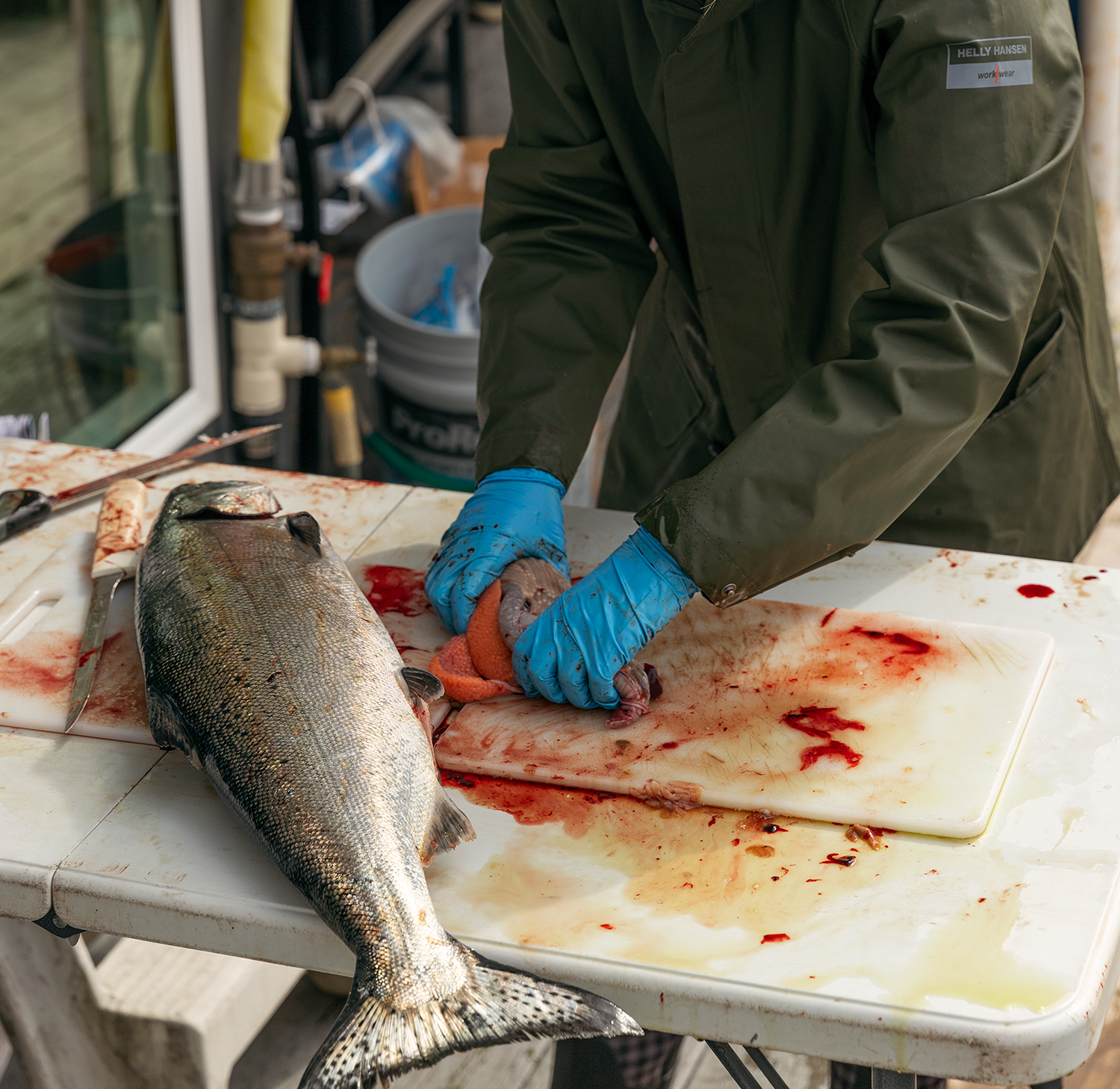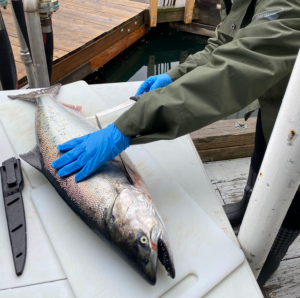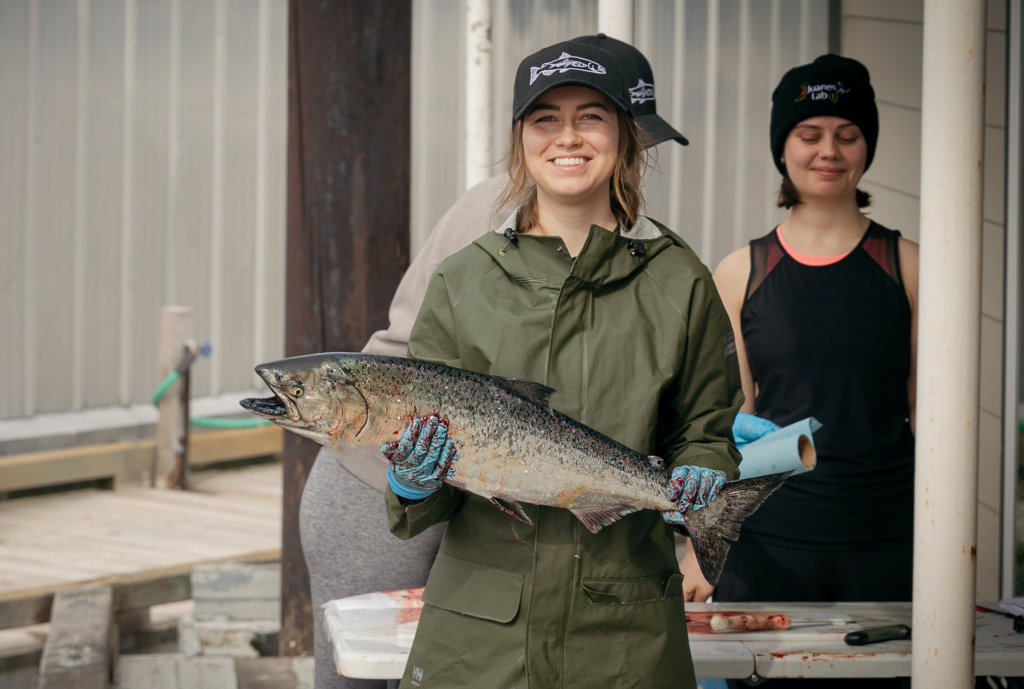Fishing For Change
Save your Stomachs – BC Adult Salmon Diet Program
The coastal ocean of Southern British Columbia is an important rearing and foraging area for migratory and resident Chinook and Coho salmon. These salmon support valuable recreational and commercial fisheries both economically and socially, as well as culturally important First Nations harvests. They also play a vital role in the ecosystem. Salmon feed on a variety of fish and marine invertebrates, and in turn provide food for other fish, birds, and marine mammals.

Most Successful Year to Date
2021 has been the most successful year of the program with 742 samples (615 chinook and 127 coho) processed to date.
If you didn’t get around to submitting a sample for the 2021 season, don’t worry. Samples for 2022 are already being collected. Consider submitting now for 2022 as all samples (full bellies or not) give valuable information to aid in furthering the data collected by the B.C. Adult Salmon Diet Program.
A Powerful Perspective on Changes in the Ecosystem
While the diets of juvenile salmon in the marine environment have been extensively studied in recent years, data on adult salmon diets in British Columbia are sparse. Improving understanding of how Chinook and Coho salmon diets vary by region, season and year, may help us understand factors limiting growth and survival of these valuable populations. Additionally, trends in salmon diets have the potential to provide us with a novel and powerful perspective on changes in the ecosystem. Such information can contribute to management measures to promote recovery and sustainable use of multiple marine species. – B.C. Adult Salmon Diet Program.
Get Involved – How to Submit Samples
While it may not be possible for you to submit all the Salmon stomachs that you capture, do not select only what appear to be full stomachs. Submit stomachs whether they appear to be full or not. Decide if you will be submitting the stomach before you clean the fish, then go through with it whether empty or full.
When cleaning a fish, cut the esophagus as close to the head/gills as possible. Attempt to make the cut as shallow as possible to avoid cutting open the digestive tract. Bag the entire digestive tract (esophagus, stomach, and intestine). If prey items are poking out from the mouth or are regurgitated, try to save them as well. If possible, keep the intestine intact with the rest of the internal organs, they will be examining intestinal contents for presence and absence of hard parts (for example otoliths – the ear bones – of prey fish; squid beaks, fish vertebrae etc..). It would be preferable if the prey was left in the stomach; however, they understand some people would like to look at the stomach contents themselves as well (To match the hatch so to speak). If you do open the stomach, ensure that you bag all the contents for submission. If you do empty out the stomach contents, it would be preferable if these are placed in a separate bag (or wrapped in cling wrap) from the rest of the internal organs and then placed together in a larger bag with the label. This prevents the stomach contents from getting mixed up with the rest of the internal organs and intestinal contents. For each bag include a card with fish-specific information. Freeze stomachs as soon as possible to limit continuing digestion. Where freezing immediately after cleaning is not possible, place baggedstomachs on ice. If it is not possible to freeze stomachs within 12 hours, please still submit the stomach, but make a note of the time that elapsed prior to freezing (they can still obtain useful information from stomachs stored on ice for up to 3 days prior to freezing).
Important Information to Include
• Species, length (Nose to Fork Length – indicate inches or cm, capture location (name) and
statistical area, hatchery (adipose clipped) or wild, and date.
• If you are an Avid Angler participant, please record your genetic sample number.
• If you are submitting the head of a hatchery fish to DFO please record the head tag code.
• Please submit heads and stomachs separately with a data card for each sample.
Catch Lots of Fish!
All they ask is that you catch lots of fish (if only it was so simple), save all the samples you can, and spread word of the program. Enquiries can be directed to willduguid@hotmail.com or juaneslabmanager@gmail.com. You can also search for, like, and share the “Southern BC Adult Salmon Diet Program” page on Facebook for updates and pictures.

Photos Courtesy of Scotty Products & BC Adult Salmon Diet Program

Drop-off Locations
Esquimalt Anglers Clubhouse (Esquimalt), Home Hardware (Sidney), Bucky’s Sports (Duncan), Harbour Chandler (Nanaimo), Tyee Marine (Campbell River), Pacific Net and Twine (Parksville), Bon Chovy Charters (Granville Island), Pacific Angler (Vancouver), Powell River Outdoors (Powell River), Bamfield Mercantile and Marine (Bamfield), Ucluelet Aquarium (Ucluelet), and Island Outfitters (Langford; limited space).
Alternative arrangements can be made to pick up or drop off samples on a case-by-case basis. Please contact juaneslabmanager@gmail.com
Learn more about this program below:
Will Duguid: The Adult Salmon Diet Program:
https://www.youtube.com/watch?v=iQXPF16hpHM
Using Chinook Salmon Diets to Understand Herring Biology: https://islandfishermanmagazine.com/using-chinook-salmon-diets-to-understand-herring-biology
The Diet of Adult Chinook and Coho Salmon:
https://storymaps.arcgis.com/stories/bb4afee2fd104761933d82cff16b0df8
Marine Data B.C:
Adult Salmon Diet Program Chinook Stomach Contents Results:
Strait of Georgia Data Centre:
https://sogdatacentre.ca/sogmrg/


